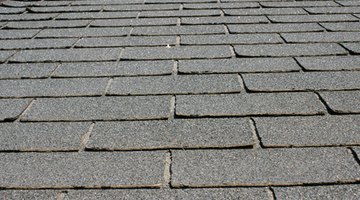How to Paint on a Steep Roof
If your house has a roof that overhangs another roof, soffit, fascia, and possibly siding will need painting at some point. Painting this section of your house that has a steep roof is impossible without a way to safely stay on it.

There is a simple, inexpensive method that will allow you to safely work off your roof and access the areas you need to paint.
Things You Will Need
- 8-foot-long 2-by-4-inch board
- Tape measure
- Pencil
- Circular saw
- 2 large clamps
- 3-inch deck screws
- Variable-speed drill
- Phillips-head drill bit
- 2 extension ladders
Tip
As a more expensive alternative, purchase two roof jack brackets, screw them to your roof 4 feet apart, and lay a 6-foot-long, 2-by-6-inch board across the brackets. The feet of your ladder will rest on the board. Use a clear roof patch in a tube to seal the screw holes when you remove your anchor board or brackets.
Warning
Do not use nails to secure your boards together, or to secure your boards to your roof. Nails are not as safe as deck screws, and they can work loose.
If you are uncomfortable or nervous, get off your roof. Doing your own painting is not worth the risk of possible death or serious injuries if you fall.
-
Mark the center of your 2-by-4-inch board, using a tape measure and pencil. The center of an 8-foot-long board is 48 inches. Place a straight edge next to your pencil marks. Use your pencil to trace a line up against your straight edge.
-
Cut your 2-by-4-inch board in half with the circular saw.
-
Clamp your two, 4-foot sections together in the shape of an L. Lay one board flat with the 4-inch side facing up, and set your second section of wood directly up against the side of the first board, with the 2-inch side facing up. The 4-inch side of the second board should be up against the 2-inch edge of the first board.
-
Drive 3-inch deck screws, with your drill, through the 4-inch side of the second board, into the 2-inch edge of the first board. Space your screws a maximum of 6 inches apart.
-
Set an extension ladder up against your house in the area that you will be working. Take your drill, at least six 3-inch deck screws, and your L board up the ladder with you. Set your L board on your roof with the tallest side sticking up. Slide your board over so that it is a minimum of 2 feet from the side of the house or overhang you will be working on. You do not want to be positioned too close, or too far away.
-
Drive your deck screws through the face of the bottom board and into the roof.
-
Carry your second extension ladder up to your roof and set the feet of your ladder up against the portion of board sticking up off the roof. You will now be able to climb onto your board and extend your ladder up your roof. Make sure your ladder is locked into position before you get on it.
The Drip Cap
- If your house has a roof that overhangs another roof, soffit, fascia, and possibly siding will need painting at some point.
- The center of an 8-foot-long board is 48 inches.
- Cut your 2-by-4-inch board in half with the circular saw.
- Slide your board over so that it is a minimum of 2 feet from the side of the house or overhang you will be working on.
- You do not want to be positioned too close, or too far away.
References
Writer Bio
Based in Oklahoma City, Debbie Tolle has been working in the home-improvement industry since 2001 and writing since 1998. Tolle holds a Master of Science in psychology from Eastern Illinois University and is also a Cisco-certified network associate (CCNA) and a Microsoft-certified systems engineer (MCSE).
Photo Credits
- roof image by kuhar from Fotolia.com
- roof image by kuhar from Fotolia.com
More Articles



